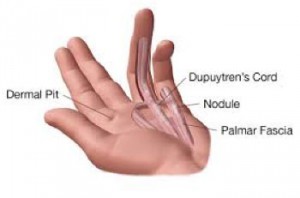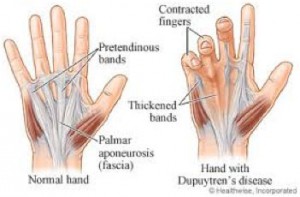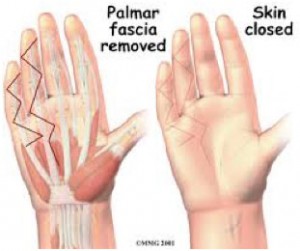Dupuytrens Contracture (Release)
 Dupuytren’s Contracture Release Surgery is a Treatment used to correct Dupuytren’s contracture, a disease that usually begins with a thickening of the skin in the palm of the hand. Eventually the disease may develop into a thick band that could make your fingers contract or pull into the palm of your hand. The exact cause of Dupuytren’s contracture is unknown, though it is thought to be a hereditary disease and not related to overuse or injury of the hand.
Dupuytren’s Contracture Release Surgery is a Treatment used to correct Dupuytren’s contracture, a disease that usually begins with a thickening of the skin in the palm of the hand. Eventually the disease may develop into a thick band that could make your fingers contract or pull into the palm of your hand. The exact cause of Dupuytren’s contracture is unknown, though it is thought to be a hereditary disease and not related to overuse or injury of the hand.
Preparation for Dupuytrens Contracture (Release)
Tell your health care provider what medicines you are taking. This includes medicines, supplements, or herbs you bought without a prescription.
- You may be asked to stop taking drugs that affect your blood’s ability to clot. These include aspirin, ibuprofen (Advil, Motrin), naproxen (Naprosyn, Aleve), and other drugs.
- Ask your health care provider which medicines you should still take on the day of your surgery.
- If you smoke, try to stop. Ask your health care provider for help. Smoking can slow healing.
- Let your health care provider know about any cold, flu, fever, herpes breakout, or other illness you may have before your surgery.
- You will usually be asked not to drink or eat anything for 6 – 12 hours before the procedure.
- Your health care provider will tell you when to arrive at the office. Arrive on time.
Dupuytrens Contracture Surgery
 During Dupuytren Contracture Release surgical treatment, the surgeon makes an incision in the hand and cuts the area of thickened tissue. This allows for improved movement of the tendons and increases finger mobility. It is a very precise surgery, because the nerves in the hand are often in this area of thickened tissue. Sometimes skin grafts are needed to replace the overlying skin. Skin grafts are performed by taking a piece of healthy skin from another area of the body (called the donor site) and attaching it to the needed area. After surgery, physical therapy helps increase strength and function
During Dupuytren Contracture Release surgical treatment, the surgeon makes an incision in the hand and cuts the area of thickened tissue. This allows for improved movement of the tendons and increases finger mobility. It is a very precise surgery, because the nerves in the hand are often in this area of thickened tissue. Sometimes skin grafts are needed to replace the overlying skin. Skin grafts are performed by taking a piece of healthy skin from another area of the body (called the donor site) and attaching it to the needed area. After surgery, physical therapy helps increase strength and function
Recovery
After Dupuytrens Contracture (Release) Surgery, it may help to elevate your hand above your heart and gently move your fingers. This may help relieve pain, swelling, and stiffness.
Your doctor may refer you to a physical therapist. Your therapist can teach you exercises to improve strength and function and improve your healing.
Some surgeons may recommend a hand splint to aid comfort and improve the position and function of your fingers. Splinting, however, is not always beneficial.
You will be encouraged to return to your activities as soon as you can.
 Risks of the Procedure
Risks of the Procedure
Both open surgery and needle aponeurotomy have a high rate of recurrence of contractures. Also, open surgery can lead to an exaggerated reaction to the wound.
Other complications of surgery include:
- Swelling and soreness
- Injury to nerves or blood vessels
- Infection
- Tissue death
